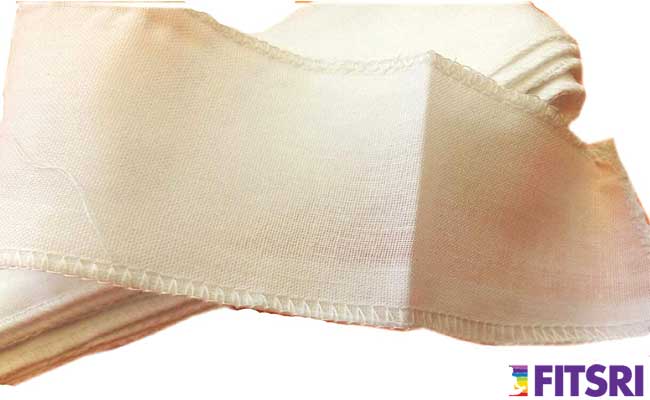- What is Vastra Dhauti?
- The Science
- Procedure
- Step-by-Step Guide
- Cloth Used for Vastra Dhauti
- Benefits of Vastra Dhauti
- Precautions
- Conclusion
- FAQs
Vastra Dhauti is an ancient yogic practice often referred to as the “Yogic Cleansing of the Stomach with Cloth,”. It focuses on purifying the upper stomach region, making it particularly effective for addressing ‘Kapha’ or phlegm-related concerns.

As we explore this practice, we will guide you through its science, procedure, recommended cloth specifications, and precautions. Additionally, we will uncover the numerous health benefits associated with Vastra Dhauti, shedding light on why it has been a cornerstone of yogic tradition for centuries.
What is Vastra Dhauti?
Vastra Dhauti is a yogic practice involving the swallowing of a moistened cotton cloth to cleanse and purify the upper stomach region.
It is part of Hatha Yoga’s purification techniques known as Shatkarma.
Vastra Dhauti involves the cleansing of the upper stomach region, where ‘Kapha dosha,’ associated with phlegm and mucus, tends to accumulate. This accumulation can lead to various health issues, including respiratory problems, skin disorders, and digestive disturbances. Vastra Dhauti is a holistic approach to mitigate these concerns by effectively clearing the upper digestive tract.
This practice of Vastra Dhauti finds roots in ancient yogic scriptures, with mentions in texts like the ‘Hatha Yoga Pradipika.’ The term ‘Vastra’ translates to “A Piece of Cloth” in Sanskrit, while ‘Dhauti’ signifies “Cleansing.” In Vastra Dhauti, a moist cotton cloth is used to cleanse the stomach. It’s an alternative to Vamana Dhauti, where water is employed for the same purpose.
A Gentle Yet Powerful Cleansing Process: Vastra Dhauti is a gentle, non-invasive practice that is particularly suitable for individuals seeking a milder form of internal cleansing compared to more intense practices. It involves swallowing a specially prepared cloth, performing certain abdominal movements, and then carefully pulling the cloth out, effectively cleaning the stomach lining in the process.
Benefits Beyond Physical Cleansing: While the primary objective of Vastra Dhauti is to clear the digestive tract of accumulated phlegm and mucus, its benefits extend to various aspects of well-being. By maintaining balanced ‘Kapha dosha,’ this practice can help alleviate respiratory disorders, improve skin health, enhance digestion, and activate the Manipura chakra, responsible for digestive fire and energy distribution.
The Science of Vastra Dhauti

To grasp the significance of Vastra Dhauti, it’s essential to delve into the intricate science that underpins this yogic practice. At its core, Vastra Dhauti revolves around the balance of ‘Doshas,’ specifically ‘Kapha’ (phlegm), and how it affects the body’s overall health and well-being.
The Three Doshas: In Ayurveda and yoga philosophy, the human body’s constitution is governed by three primary Doshas: ‘Kapha,’ ‘Pitta,’ and ‘Vata.’ These Doshas are responsible for various physiological and psychological functions, and an imbalance in any of them can lead to health issues.
- Kapha Dosha: Kapha represents the elements of water and earth and is associated with qualities like heaviness, coldness, and stability. When imbalanced, it can lead to an accumulation of phlegm, mucus, and excess moisture in the body.
Also read: What is water element in our body good for?
The Role of Kapha in Health: The food and beverages we consume produce waste products. Over time, these waste products can become trapped in the Oesophagus (gullet) and accumulate, eventually transforming into phlegm and mucus. The effects of excessive mucus can be observed during colds, while phlegm may manifest as coughing or wheezing. Consequently, the buildup of these waste products leads to an imbalance in the ‘Kapha dosha.’
Vastra Dhauti’s Solution: Vastra Dhauti is performed to remove blockages caused by mucus in the respiratory tracts and to regulate excess gastric juice secretions. In doing so, it helps restore balance to the ‘Kapha Dosha’ within the body. This, in turn, contributes to the alleviation of skin diseases, common fever, and respiratory disorders.
By understanding the relationship between ‘Kapha dosha’ and health issues, we can appreciate the vital role of Vastra Dhauti in maintaining overall well-being.
Vastra Dhauti Procedure

Now that we have a foundational understanding of Vastra Dhauti and its significance, let’s delve into the step-by-step procedure of this ancient yogic practice. Vastra Dhauti involves a gentle yet powerful process of purifying the upper stomach region.
Preparation: Before you begin, ensure that you have the following items ready:
- Vastra (Cloth): The cloth used for Vastra Dhauti should meet specific criteria. It should be a finely woven cotton cloth, approximately 20 to 25 feet in length and 2 to 3 inches in width (slightly less than the width of the tongue). Ensure that all corners of the cloth are neatly trimmed to prevent fraying.
- Warm Saltwater: Prepare a bowl or pot of warm water and mix a small amount of salt (approximately 2 teaspoons per litre) into it. The saltwater is used to moisten the cloth for ease of swallowing.
- Glass of Warm Drinking Water: Keep a glass of warm drinking water nearby for sipping during the practice.
Step-by-Step Guide to Vastra Dhauti
- Relax and Prepare: Begin by relaxing your body. You can sit in a squat pose (Utkatasana) with your heels on the ground and buttocks slightly off the ground, or sit with a straight spine in Sukhasana (cross-legged position) if it’s more comfortable for you.
- Moisten the Cloth: Take one end of the long cotton cloth and dip it completely into the warm saltwater, making it wet. Ensure that the cloth is thoroughly moistened but not dripping.
- Position the Cloth: Spread one end of the cloth, at its maximum width, over your tongue while keeping the other end submerged in the bowl of saltwater.
- Swallow the Cloth: Hold the upper end of the cloth near your mouth and slowly begin swallowing the moist cloth. If the cloth gets caught or stuck at any point during the swallowing process, you can take a small sip of warm water to aid its progression.
- Abdominal Movements (Nauli): Once the cloth is swallowed almost completely inside, stand up to practice abdominal movements known as Nauli. These movements help ensure effective cleansing. Move your stomach from right to left, left to right, and in a circular motion. Beginners can simply churn the stomach from side to side. Practice these movements for 5 to 10 minutes, ensuring that the cloth is thoroughly manipulated.
- Pulling the Cloth Out: After completing the abdominal movements, sit back in a squatting position and gently pull the cloth out. As you pull it out, you will notice that it carries with it a sticky substance and mucus from the inner lining of the intestinal tract. Rinse and sterilize the cloth for future use.
Note: It’s crucial not to drink a large quantity of water while swallowing the cloth. The intention is to fill the stomach with the cloth, not water.

Also check: How is Nauli performed?
By following this step-by-step procedure, you can engage in the practice of Vastra Dhauti effectively and safely.
Cloth Used for Vastra Dhauti

The choice of cloth for Vastra Dhauti is of paramount importance, as it directly impacts the effectiveness and safety of this yogic practice.
Dimension of Vastra Dhauti Cloth: The cloth used in Vastra Dhauti should adhere to specific dimensions to ensure a smooth and safe practice:
- Length: The ideal length of the cloth should be between 20 to 25 feet. This length allows the cloth to reach the upper stomach region effectively without excessive material.
- Width: The width of the cloth should be approximately 2 to 3 inches, which is slightly less than the width of the tongue. This width facilitates ease of swallowing and minimizes discomfort.
Material of the Cloth: Selecting the right material for the cloth is crucial for the success of Vastra Dhauti:
- Finely Woven Cotton: The cloth used for Vastra Dhauti should be made of finely woven cotton. This natural material is gentle on the digestive tract and is less likely to cause irritation or discomfort during the practice.
Trimmed Corners: To prevent any fraying or unraveling during the practice, it’s essential to ensure that all corners of the cloth are neatly trimmed. This attention to detail enhances the safety and effectiveness of Vastra Dhauti.
Choosing the right cloth material and adhering to the specified dimensions are critical aspects of Vastra Dhauti. The correct cloth ensures that the practice is comfortable and safe, allowing you to focus on the cleansing process without unnecessary distractions.
Benefits of Vastra Dhauti
Vastra Dhauti offers a wide array of benefits that extend beyond physical purification. By effectively cleansing the upper stomach region and balancing the ‘Kapha dosha,’ Vastra Dhauti contributes to holistic well-being.
Here are some of the remarkable benefits associated with Vastra Dhauti:
1. Cleansing and Detoxification: Vastra Dhauti removes impurities from the intestinal tract, detoxifying the stomach and esophagus regions. This cleansing process helps maintain a clean path for food and beverages, ensuring they reach the stomach without obstruction.
2. Alleviation of Digestive Issues: For those struggling with gas, acidity, or indigestion, Vastra Dhauti can be particularly beneficial. By reducing the accumulation of waste and toxins in the upper digestive tract, it supports improved digestion and alleviates discomfort.
Also read: Which hand mudra is good for acidity?
3. Respiratory Health Enhancement: Vastra Dhauti aids in relieving respiratory conditions associated with excess phlegm and mucus. It can be effective in addressing asthma, bronchitis, cough, and other ‘Kapha’ or phlegm-related problems by promoting clearer airways.
4. Preparation for Pranayama: A clean throat and upper digestive tract are essential for effective Pranayama (breathing exercises). Vastra Dhauti serves as a preparatory practice, ensuring unobstructed airflow during advanced breathwork.
5. Skin Health Improvement: The practice of Vastra Dhauti can contribute to enhanced skin health by cleansing the stomach of toxins. This can result in a reduction in skin issues such as acne, itching, and other related disorders.
Check: Does face yoga really work? Can yoga improve skin?
6. Digestive Harmony: A healthy stomach is pivotal for overall digestive harmony. Vastra Dhauti supports the effective functioning of the digestive system, helping to maintain balanced digestion and prevent digestive disturbances.
7. Activation of Manipura Chakra: Vastra Dhauti stimulates the Manipura chakra, located in the solar plexus region. This chakra is associated with igniting the digestive fire (agni) and promoting vitality in the abdominal area.
8. Respiratory Organ Strengthening: Consistent practice of Vastra Dhauti strengthens the organs of the respiratory system, leading to improved respiratory health and the activation of the immune system.
Vastra Dhauti Precautions
While Vastra Dhauti offers numerous benefits for cleansing and balancing the body, it’s essential to approach this practice with mindfulness and awareness.
Here are some important precautions to consider before engaging in Vastra Dhauti:
1. Guidance from an Expert:
- Vastra Dhauti should be performed under the guidance of an experienced yoga teacher or practitioner who is well-versed in this practice. Proper instruction ensures that you are following the correct technique and reduces the risk of injury.
2. Avoid High Blood Pressure and Heart Conditions:
- Individuals with high blood pressure or heart conditions should refrain from practicing Vastra Dhauti. The practice can exert pressure on the cardiovascular system, making it unsuitable for those with pre-existing heart issues.
3. Three-Hour Rule:
- Practice Vastra Dhauti at least three hours after your last meal. Performing the practice on a full stomach can lead to discomfort and complications.
4. Swallowing Technique:
- Pay careful attention to the swallowing technique. Do not rush the process, and if the cloth gets stuck or causes discomfort, pause and seek guidance. Never force the cloth down.
5. Minimal Cloth Moistening:
- Ensure that the cloth is only moistened, not dripping wet. Excessive moisture can make the cloth difficult to swallow and increase the chances of choking.
6. Gradual Progression:
- If you are new to Vastra Dhauti, start with shorter lengths of cloth and gradually increase the length as you become more comfortable and experienced. Rushing into longer cloth lengths can be challenging and uncomfortable.
7. Resistance to Vomiting Urge:
- At times, the cloth may trigger the urge to vomit. It’s important to resist this urge and allow the practice to continue. The urge typically subsides as the cloth progresses further into the esophagus.
8. Avoid Drinking Water During Practice:
- Do not consume large quantities of water during the practice. The intention is to fill the stomach with the cloth, not water. Drinking excess water can disrupt the practice.
9. Thorough Cleansing:
- After pulling out the cloth, make sure to thoroughly clean and sterilize it before future use. Hygiene is essential to prevent contamination.
By adhering to these precautions, you can approach Vastra Dhauti with a greater degree of safety and confidence. It’s essential to prioritize your well-being and practice mindfully, ensuring that you experience the benefits of this transformative yogic technique while minimizing potential risks.
Conclusion
Vastra dhauti involves swallowing a specially prepared cotton cloth, performing abdominal movements, and then carefully pulling the cloth out to cleanse the upper stomach region. Its benefits extend beyond the physical, encompassing improved respiratory health, preparation for advanced yoga practices, enhanced skin health, digestive harmony, and more.
However, it’s crucial to approach Vastra Dhauti with mindfulness and care. Practising under the guidance of an experienced yoga teacher, especially if you are a beginner, is strongly recommended. Additionally, individuals with high blood pressure, heart conditions, or specific medical concerns should exercise caution or seek medical advice before attempting this practice.
FAQs about Vastra Dhauti
Vastra Dhauti is a yogic practice involving the swallowing of a moistened cotton cloth to cleanse and purify the upper stomach region. It is part of Hatha Yoga’s purification techniques known as Shatkarma.
The procedure for Vastra Dhauti includes swallowing a moistened cotton cloth, performing abdominal movements called Nauli, and then carefully pulling the cloth out to cleanse the upper digestive tract. Detailed instructions can be found in the article.
Vastra Dhauti offers benefits such as detoxification of the stomach and esophagus, relief from digestive issues like gas and acidity, improved respiratory health, preparation for advanced yoga practices, and enhanced skin health.
Risks include choking if not done correctly, discomfort, and potential complications for individuals with high blood pressure or heart conditions. Proper guidance and technique are crucial to minimize risks.
The recommended cloth length for Vastra Dhauti is 20 to 25 feet. Beginners can start with shorter lengths and gradually progress to longer ones.
Vastra Dhauti can be safe when practiced correctly and under supervision. It may not be suitable for individuals with specific medical conditions, so consult a healthcare professional or yoga teacher.
The frequency of Vastra Dhauti varies. Some practice it regularly, while others do it periodically. Consult with a qualified yoga teacher to determine a suitable frequency for your practice.
Improper practice can lead to discomfort, choking, or complications. To minimize harm, follow proper technique, start with shorter cloth lengths, and practice under supervision.
Vastra Dhauti should be avoided by individuals with high blood pressure, heart conditions, or certain medical concerns. Pregnant women and those with gastrointestinal disorders should consult a healthcare professional before attempting it.
Use finely woven cotton cloth for Vastra Dhauti. The material should be clean and hygienic, with no specific restrictions on cotton type. Quality and cleanliness are more critical than the specific type of cotton.
The post Vastra Dhauti (Yoga Stomach Cleansing Technique): Procedure, Benefits & Safety appeared first on Fitsri Yoga.